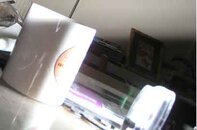So, have you adjusted the YS-01 for pre-flash or no pre-flash? It's on the mode switch on left in back, has either a double lightning bolt symbol (for pre-flash camera aettings) or a single "bolt" for no pre-flash.
http://www.seaandsea.com/PDF_manuals/YS01.pdf. Sea & Sea suggests using force flash so their strobe gets the signal to fire every time but you need to figure out your camera enough to decide how you want to use it. For example, if you go to Shutter priority and set 1/125th or higher
probably the camera will fire it's flash all the time UW, so you might get around having to set it in force flash mode. I mention this because it's possible that in force flash mode the camera loses it's TTL abilities, can't say. Time for some camera manual reading to figure this part out. Oh, you can get by w/ a few test firings and not overheat the strobe above water but yes, don't go blasting away.
Avoid red eye reduction mode, no need for it UW and it can mess around w/ the slaved strobe's ability to fire in synch w/ the camera. As for ISO--well, what do you like? If you go too high you probably won't like the image "noise" being generated so do some tests, look at the results by zooming in on your computer monitor (view at least at 100%!), NOT by how it looks on the camera screen. Look at shadows and smooth toned areas like sky or skin tones. Most folks opt for lower ISO settings (80-100) but you need to decide what you like from your camera and part of that should be based on how you plan to use the shots. For small, online images--who cares, you won't see much noise or problem. Big enlargements? Bet you won't like the higher ISO settings (above 200), especially if you have to crop much.
White balance. The flash output matches daylight. Some folks use a cloudy/bright etc setting to tweak things but the key is get close. Beyond about 4-6' (or 1-2M) the flash doesn't do much good. Let the strobe provide the light for the scene and keep the auto white balance in a daylight mode of some sort. If you set say UW balance ("fish" symbol?) the camera tries to correct for lack of red due to the water progressively absorbing the "warmer" reddish wavelengths. Ah, but then you come along and dump this big blast of "daylight" balanced light from your strobe, which makes the close in areas look way too red because of the camera being set for UW color balance, which is adding more red to correct the very blue uw light.
If all this begins to sound a bit daunting (and I fear I've over simplified a lot!), not to worry. Go to UW Photographers Guide
Underwater Photography Guide and Scott Gietler & company will provide a wealth of easy to understand info. That should make things fun again and much less frustrating. Hmmm, probably should have just sent you there first!

// ww



 ). Maybe set the shutter speed around 1/125 and go from there. If you start getting consistent results you may still need to tweak exposures but at least things should become reliable. Check back in if there are still problems. I used to shoot a Fuji F-30 and enjoyed the camera, your should do fine with this setup. // ww
). Maybe set the shutter speed around 1/125 and go from there. If you start getting consistent results you may still need to tweak exposures but at least things should become reliable. Check back in if there are still problems. I used to shoot a Fuji F-30 and enjoyed the camera, your should do fine with this setup. // ww
